How To Make Solid Chocolate Eggs
No Easter basket would be complete without a few chocolate eggs nestled among the jelly beans and chocolate bunnies.
You don't need to go to a gourmet chocolate shop to buy your chocolate Easter eggs. It's easy to make them at home!
In this post, you will learn how to make solid milk, dark, or white chocolate eggs, and chocolate bark eggs filled with nuts, candies, cookies, and more.

I have been busy making and sharing recipes to make a variety of chocolate Easter eggs this year. So far I've shared recipes to make hollow chocolate eggs and chocolate eggs filled with delicious fudge, caramel, ganache, and more.
You can find recipes to make all of these delicious chocolate eggs by clicking on the links below.
-
- peanut butter eggs
- caramel eggs
- marshmallow eggs
- coconut cream eggs
- chocolate truffle eggs
- hollow Easter egg hot chocolate bombs
- breakable candy-filled chocolate Easter eggs
Today, I'm going to show you how to make solid chocolate eggs and chocolate bark eggs. They are the easiest eggs to make at home.

We'll start by talking about chocolate.
If you've already read any of my other chocolate egg recipe posts you can skip this part.
Chocolate
You can use:
- pure chocolate that contains cocoa butter and needs to be melted and tempered (heated and cooled to specific temperatures)
- available in dark chocolate, milk chocolate, or white chocolate
- compound chocolate (also known as confectionery coating, candy melts, melting wafers, or almond bark) that contains palm kernel oil and only needs to be melted
-
- available in dark, light, white, or a variety of colors
-
Recommended chocolates:
- Dark chocolate (semi-sweet or bittersweet) contains chocolate liquor (a mixture of cocoa solids and cocoa butter) and sugar.
- I recommend using chocolate that is between 50-60% cocoa if you prefer a mellow chocolate flavor.
-
- Burgundy Chocolate made by Peter's (my favorite!)
- Callebaut semi-sweet chocolate
-
- If you use chocolate with a higher cocoa content, between 60-72%, your chocolate ganache will have a more robust and bitter flavor.
-
- Callebaut 70% Callets
- Lindt Excellence 70% Chocolate Bars
-
- I recommend using chocolate that is between 50-60% cocoa if you prefer a mellow chocolate flavor.
- Milk Chocolate contains chocolate liquor, sugar, and milk.
- Peter's Ultra Milk Chocolate (my favorite!)
- Callebaut Milk Chocolate Callets (also really delicious)
- White Chocolate contains cocoa butter, sugar, and milk.
- Ghirardelli Premium White Bars
- Lindt White Chocolate Bars
- Callebaut White Chocolate Callets
Recommend Compound Chocolates (candy melts):
I personally prefer the flavor of Peter's compound chocolates (Easterchester = dark chocolate, Westchester = milk chocolate, and Icecaps = white chocolate) but this compound chocolate is not always easy to find. If you have a cake/candy decorating store in your area, they will probably carry it.
You can also find Merckens, Guittard A'Peels, and Van Leer compound chocolates at candy decorating stores and online.
If you don't have a local cake and candy shop, you can also find various types of compound chocolate at grocery and craft stores or online.
- Ghirardelli Melting Wafers (milk, dark, and white)
- Wilton Candy Melts
- CandiQuik
- Almond Bark
I highly recommend learning how to melt and temper pure chocolate because the flavor of pure chocolate is superior to compound chocolate, but you can use either when making your chocolate eggs.

Start by melting your chocolate. You can use the stovetop or the microwave.
Melt the chocolate on the stove using a double boiler.
- You can melt your chocolate in a double boiler set over low heat.
- Fill a pot with 1-inch of water and set a tight-fitting bowl over the opening of the pan.
- Fill the bowl with chocolate and heat on low stirring often until melted.
- Be careful that no water or steam gets into your chocolate. When you pick the bowl up off the pot be sure to wipe the water off the bottom of the bowl.
If you are using compound chocolate (candy melts, almond bark, etc.) then you are ready to make your chocolate bomb Easter eggs. If you are using pure chocolate, you must follow the instructions listed below for tempering your chocolate.

Melting Chocolate in the Microwave
If you are using bars or blocks of chocolate, chop it into very small uniform-size pieces.
- Pour your chocolate or candy melts into a microwave-safe bowl.
- Heat on high power for 30-second bursts of power, stirring after each, until about 75% of the chocolate pieces have melted.
- Then heat at high power for 15-second bursts of power until most of the chocolate has melted.
- Set the bowl aside for a minute or two then stir again. The residual heat in the bowl will help to melt the remaining pieces of chocolate.
- If needed, heat for an additional 15 seconds, and stir until melted.
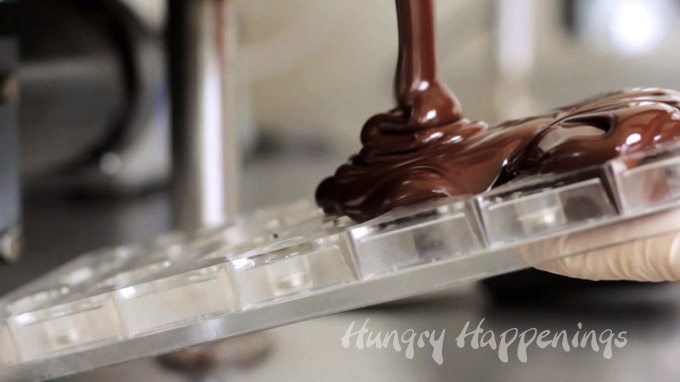
Tempering Pure Chocolate
Tempering is the process of heating and cooling pure chocolate to specific temperatures so that your candy hardens properly. You can read a detailed explanation of tempering on my chocolate-making tips page. I'll share a brief overview below.
When you purchase chocolate it will be in temper. It should look shiny and it should snap when broken.
Once you melt pure chocolate above certain temperatures it will go out of temper. You can carefully melt your chocolate so that it doesn't go above these temperatures (88-91 °F for dark chocolate; 86-88°F for milk and 82-84°F for white) but that can be tricky.
If the chocolate gets heated even a degree or two over those temperatures, your chocolate will go out of temper, which means the chocolate will not harden properly, will stick inside the molds, and will bloom (become spotty). So, I recommend using the seeding method to temper your chocolate.
seeding method of tempering
- Melt 3/4's of your finely chopped chocolate.
- You need to heat dark chocolate to 115°-120° Fahrenheit, milk chocolate to 110°-115° F, or white chocolate to 105-110° F.
- Begin to cool the chocolate by stirring in about 1/2 of your reserved chocolate. Continue to stir, scraping down the sides of the bowl until all of those chocolate pieces have melted.
- Check the temperature of the chocolate.
- Your goal is to get the chocolate to 88-91 °F for dark chocolate; 86-88°F for milk and 82-84°F for white.
- Continue to sprinkle in small amounts of the chocolate and stir to cool the bowl of chocolate until you reach the high end of the temperatures listed above.
- Once the chocolate reaches that temperate, remove any unmelted chocolate pieces and check the temper by dipping a metal spatula, spoon, or knife into the chocolate. Shake off any excess chocolate and set it aside for 3-5 minutes. If the chocolate has hardened and looks shiny, it is in temper.
- If the chocolate doesn't harden on the spatula then your chocolate is too hot and needs to be cooled further.
- If the chocolate looks streaky or spotty, then the chocolate has cooled too much, and you'll need to heat it up a bit, just be careful it doesn't go above the top temperature listed above for each type of chocolate.
- If the chocolate goes below the tempering temperatures (example: below 88 degrees F for dark chocolate), you can carefully reheat it in the microwave (3-5 seconds) or in the double boiler just until it reaches the higher temperature (example: 91 degrees F for dark chocolate).
NOTES:
- During the process of making these chocolate eggs, you will need to retemper your chocolate so it's good to have more chocolate on hand so that you can reheat the chocolate in your bowl and seed it with more solid (tempered) chocolate.
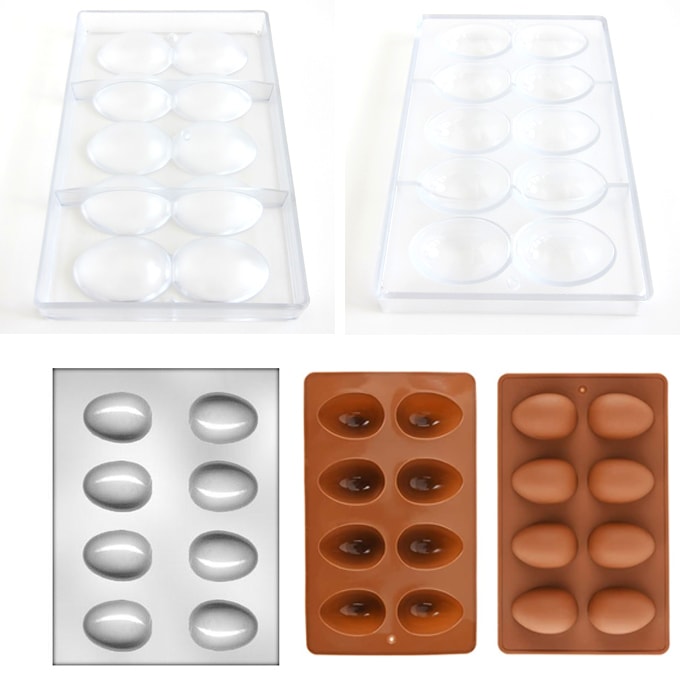
Egg Molds
You can use any of the mols listed below:
- polycarbonate egg molds (my favorite!)
- imprinted polycarbonate egg molds with design
- hobby-grade plastic egg molds
- silicone egg molds
I love my polycarbonate egg molds, especially when I'm making hollow or filled eggs, but when making solid chocolate or chocolate bark eggs, the plastic hobby-grade molds and the silicone molds work just as well.
Other supplies you'll need to make your chocolate eggs:
- microwave-safe bowls or a double boiler
- silicone spatula
- offset metal spatula
- metal bench scraper (or use a putty knife that's only used for chocolate work)
- optional, food-use only paintbrush if you plan to use silicone molds
- food handling gloves are imperative when working with chocolate that you wear gloves so that you
- disposable pastry bags or parchment paper cones
- parchment paper or wax paper set on cookie sheets or cutting boards
- an instant-read thermometer is a must if you plan to temper pure chocolate (my favorite is a Themapen)
Buying Chocolate & Supplies
You can order everything you need to make these chocolate eggs from Amazon. I earn a small commission at NO extra cost to you when you use the affiliate links below.
Video
Watch the video to see how to make solid 3-D chocolate Easter eggs.
Making chocolate bark eggs is as easy as mixing ingredients into the chocolate and spooning it into the mold. Scroll down for the step-by-step instructions.
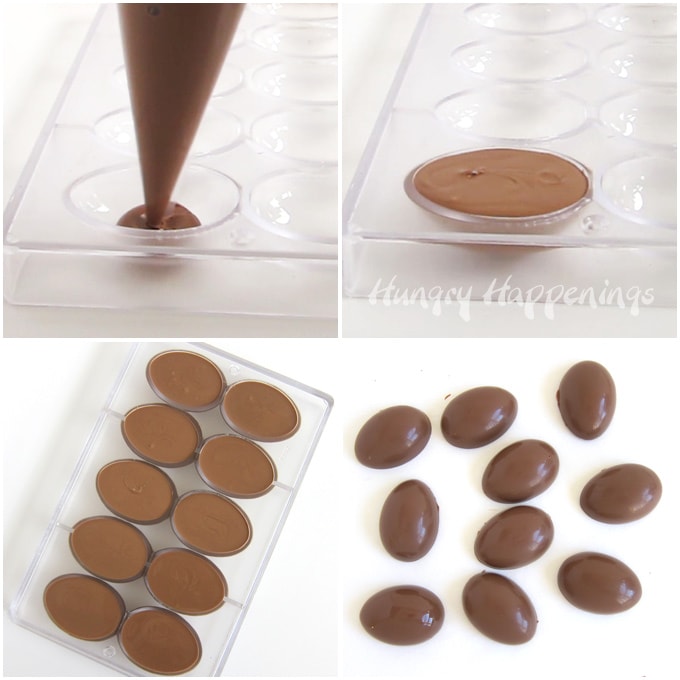
Solid Chocolate Eggs
Making homemade chocolate eggs is so easy.
- Fill each egg cavity in your candy mold with milk, dark, or white chocolate.
- I found it easiest to fill a disposable pastry bag with chocolate and to pipe it into the egg mold.
- You can spoon it in or pour it into the mold if you prefer.
- Tap the mold on the counter a few times to allow air bubbles to come to the surface and pop.
- If using pure chocolate, place the chocolate in the refrigerator for about 30 minutes or so until the chocolate hardens.
- If you used compound chocolate (candy melts, almond bark, etc.) chill the chocolate in the freezer for about 15 minutes until hardened.
- Once the chocolate eggs have hardened, they will retract (pull away) from the mold and will come out easily.
- Set a cutting board or baking pan over the mold, flip the mold and board upside down then allow the chocolate eggs to fall out.
- If they don't fall out, then crack the mold like you do an ice cube tray (bending it slightly back and forth) to loosen the chocolates.
- If the chocolates won't release from the mold, chill them for a few more minutes and try again.
- If after 45 minutes, you cannot get the chocolate out of the mold, it sadly may never come out. If the chocolate wasn't properly tempered, it may stick inside the mold. You can try to freeze the mold for a few minutes and try again. Otherwise, you will need to wash the chocolate out using hot water.
- If you are using a silicone mold, you may need to tug at the mold around the top edge of the chocolate, then push the eggs out.
You can wrap your eggs in foil, serve them on a platter, or attach another half if you want thick 3-D chocolate eggs.
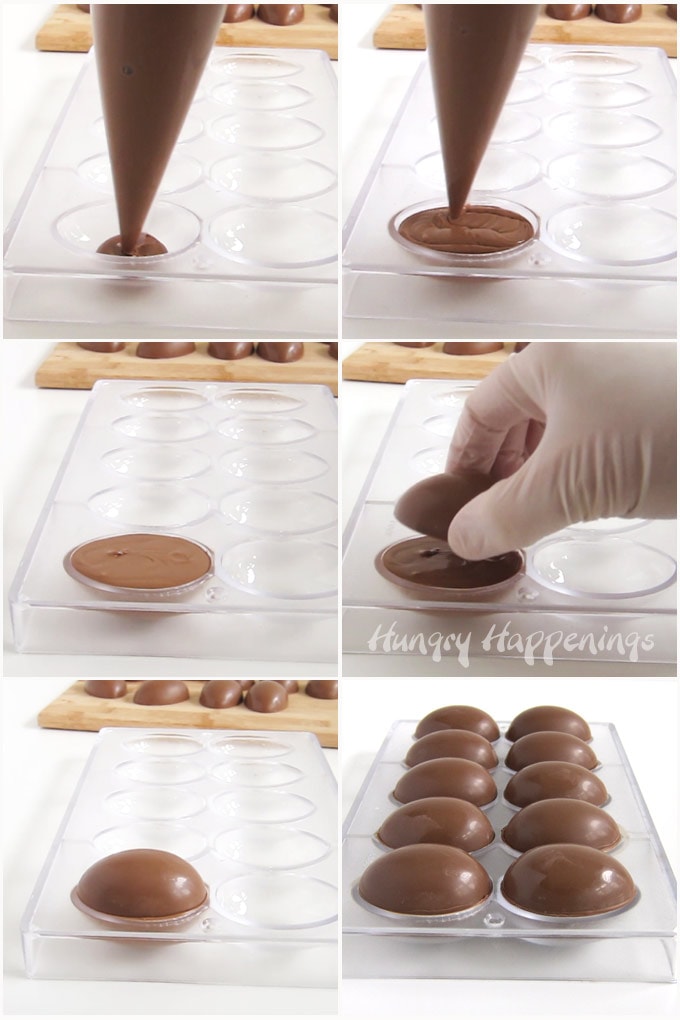
3-D Chocolate Eggs
If you want to make a three-dimensional chocolate egg, you can attach two halves together.
- You can "glue" two halves together using a very thin layer of chocolate.
- Or, you can melt the bottom of one half slightly (heat a skillet over medium heat for about 20 seconds, then set the flat side of the egg into the skillet, and allow it to melt slightly) then press the two halves together.
- Or you can attach one solid chocolate egg-half to a wet (melted) chocolate egg-half. This is my preferred method.
Attach a solid egg to a wet (melted) egg.
- Make one batch of chocolate eggs and remove them from the mold. Allow the eggs to come to room temperature before proceeding with the next steps.
- Fill an egg cavity with chocolate.
- Tap the mold a few times to allow air bubbles to come to the surface and pop.
- Make sure the egg cavity is completely filled with chocolate (scrape off any excess chocolate if needed).
- Immediately press a chocolate egg-half over the wet chocolate.
- Repeat, making more eggs.
- Chill the eggs in the refrigerator, if using pure chocolate, or in the freezer, if using compound chocolate (candy melts, almond bark, etc.) until the egg hardens.
- Remove and pop the eggs out of the mold.
- If needed, you can use a sharp knife to remove any excess chocolate around the seam.
You can use this technique with any size chocolate egg including mini eggs.
If you prefer hollow chocolate eggs, be sure to check out the Breakable Chocolate Easter Egg recipe post.
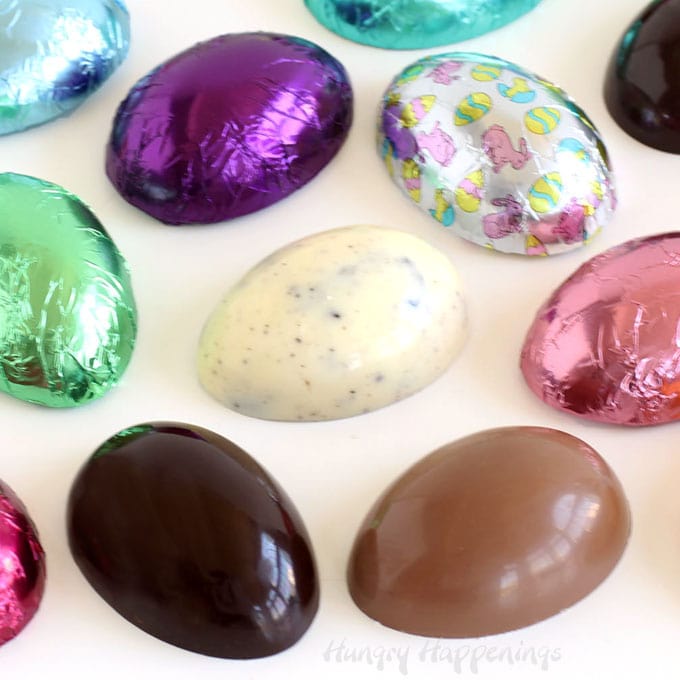
I personally prefer eating chocolate eggs that have a flat bottom because they are thin enough to easily bite into. I also like to fill my egg with yummy ingredients like nuts, cookies, pretzels, and more.
Chocolate Bark Eggs
If you have ever made chocolate bark by blending chocolate with nuts, cookies, pretzels, and more, you know how easy it is to make.
Typically you spread the chocolate mixture into a thin layer then when it hardens you break it into pieces that look like tree bark, thus the name, chocolate bark.
To make chocolate bark eggs, you simply spoon the chocolate mixture into an egg mold, allow it to harden, then pop the chocolate eggs out of the mold.
Here are some of my favorite mixins for chocolate bark:
- toffee bits
- peanuts, cashews, almonds
- cookies (OREO, Biscoff, Nutter Butter)
- dried fruit (cherries, blueberries, apricots, mango)
- cereal (Rice Krispies Cereal, Frosted Flakes, Cap'n Crunch)
- pretzel snaps or pretzel sticks
- toasted coconut
- caramel bits (small balls of caramel)
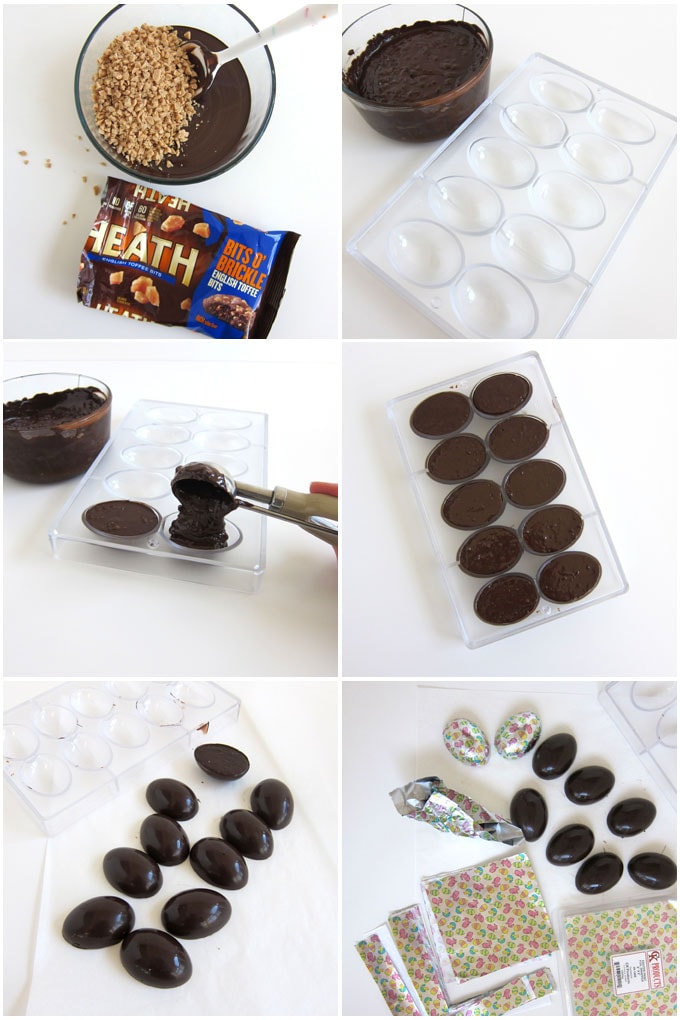
Toffee Bark Eggs
- Stir together 12 ounces of melted and tempered pure chocolate or 12 ounces of melted compound chocolate with 1/3 cup Heath Toffee Bits.
- Spoon the chocolate into the egg mold.
- I used an #30 ice cream scoop to fill my chocolate eggs.
- Tap the mold to allow the chocolate to fill in the egg cavity and to allow any air bubbles to come to the surface and pop.
- Repeat, filling the entire mold with the chocolate and toffee mixture. This should make 8-10 eggs, depending on the size of the mold you use.
- Chill in the refrigerator if using pure chocolate for 30 minutes until hardened or in the freezer, if using compound chocolate (candy melts, almond bark, melting wafers) for about 15 minutes until hardened.
- Remove them from the fridge and unmold them.
- Set a cutting board or baking pan over the top of the mold.
- Flip it and the mold upside down.
- Lift up the candy mold and the chocolate eggs should fall right out.
- If they are stuck, crack the mold (like you do with an ice cube tray) to release them from the mold.
- If they won't come out, chill them longer and try again.
- Let the eggs come to room temperature before packaging them.
- You can wrap them in foil candy wrappers or in a clear cellophane bag tied with a ribbon or simply set them on a plate and serve them.
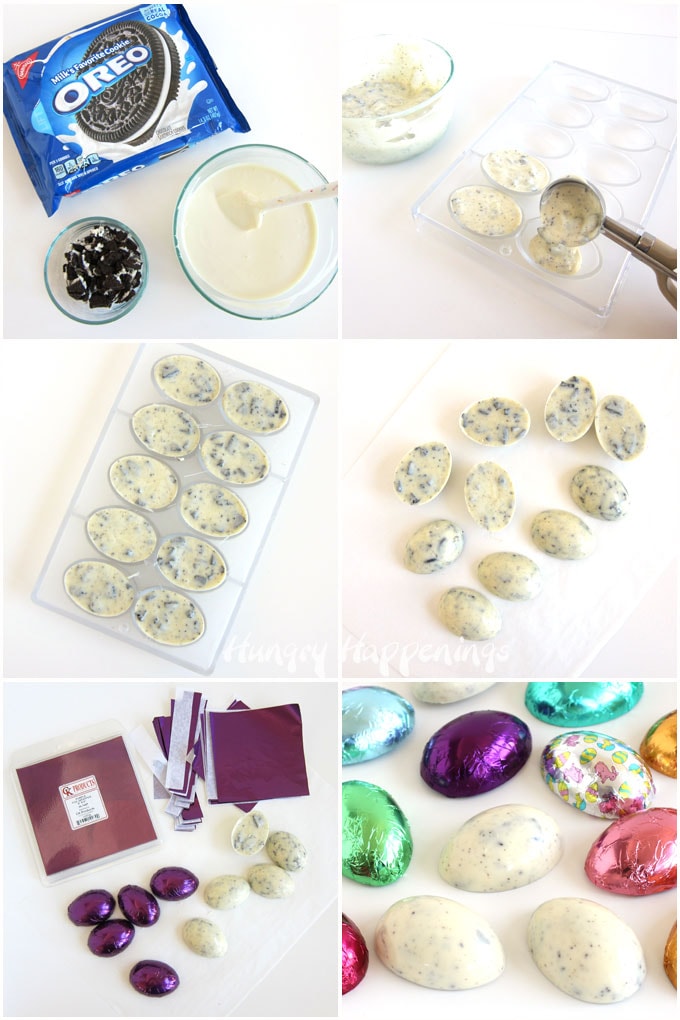
Cookies and Cream Easter Eggs
- Stir together 12 ounces of melted and tempered pure white chocolate or 12 ounces of melted white compound chocolate with 10 OREO Cookies broken into very small pieces.
- Spoon the OREO white chocolate into the egg mold.
- I used an #30 ice cream scoop to fill my chocolate eggs.
- Tap the mold to allow the chocolate to fill in the egg cavity and to allow any air bubbles to come to the surface and pop.
- Repeat, filling the entire mold with the cookies and cream mixture. This should make about 8-10 eggs, depending on the size of the mold you use.
- Chill in the refrigerator if using pure chocolate for 30 minutes until hardened or in the freezer, if using compound chocolate (candy melts, almond bark, melting wafers) for about 15 minutes until hardened.
- Remove them from the fridge and unmold them.
- Set a cutting board or baking pan over top of the mold.
- Flip it and the mold upside down.
- Lift up the candy mold and the chocolate eggs should fall right out.
- If they are stuck, crack the mold (like you do with an ice cube tray) and see if they come out.
- If not, chill them longer and try again.
- Let the eggs come to room temperature before packaging them in foil wrappers or cellophane bags.
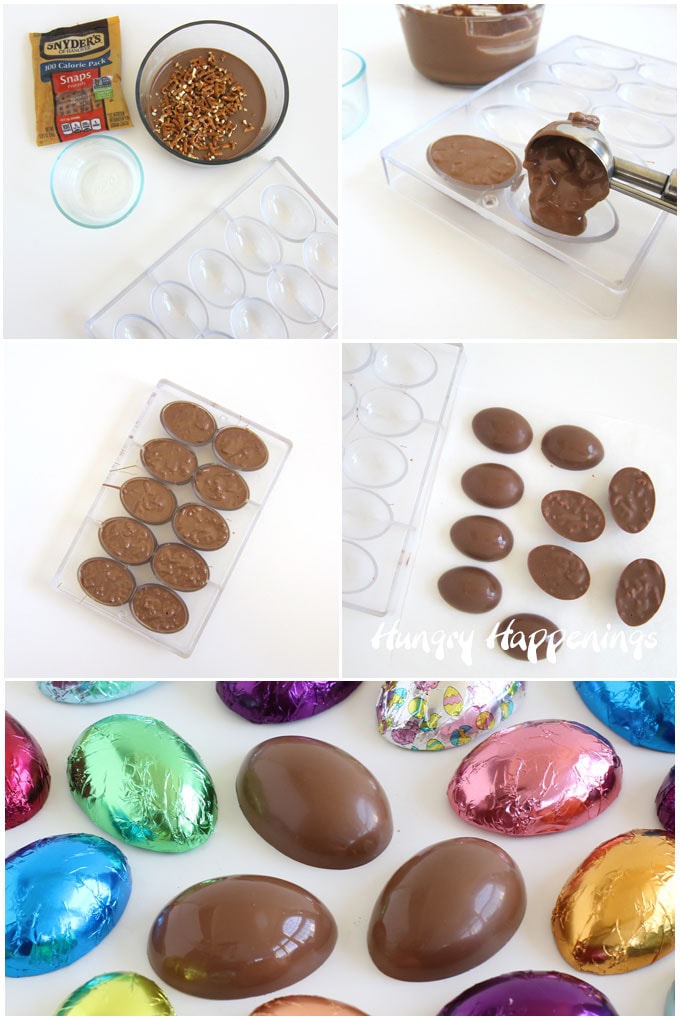
Milk Chocolate Pretzel Eggs
- Stir together 12 ounces of melted and tempered pure chocolate or 12 ounces of melted compound chocolate with 1/2 cup pretzels, broken into very small pieces.
- I like using the pretzel snaps (the square grid-style pretzels) or the thin pretzel sticks instead of thicker pretzel twists.
- Spoon the chocolate pretzel mixture into the egg mold.
- I used an #30 ice cream scoop to fill my chocolate eggs.
- Tap the mold to allow the chocolate to fill in the egg cavity and to allow any air bubbles to come to the surface and pop.
- Repeat, filling the entire mold with the chocolate and pretzel mixture. This should make 8-10 eggs, depending on the size of the mold you use.
- Chill in the refrigerator if using pure chocolate for 30 minutes until hardened or in the freezer, if using compound chocolate (candy melts, almond bark, melting wafers) for about 15 minutes until hardened.
- Remove them from the fridge and unmold them.
- Set a cutting board or baking pan over top of the mold.
- Flip it and the mold upside down.
- Lift up the candy mold and the chocolate eggs should fall right out.
- If they are stuck, crack the mold (like you do with an ice cube tray) and see if they come out.
- If not, chill them longer and try again.
- Let the eggs come to room temperature before packaging them in foil wrappers or cellophane bags.

Butterscotch Crunch Eggs
Butterscotch chips can be used to make chocolate eggs. You simply melt the chips (they are compound chocolate and do not need to be tempered) using a double boiler set over low heat on the stove or in the microwave. See the melting instructions above.
- Stir together 12 ounces of melted butterscotch chips with 1/2 cup of Rice Krispies Cereal.
- Spoon the butterscotch and Rice Krispie mixture into the egg mold.
- Tap the mold to allow the chocolate to fill in the egg cavity and to allow any air bubbles to come to the surface and pop.
- Repeat, filling the entire mold with the chocolate and pretzel mixture.
- This should make about 8-10 eggs, depending on the size of the mold you use.
- Chill in the freezer for about 15 minutes until hardened.
- Remove them from the freezer and unmold them.
- Let the eggs come to room temperature before packaging them in foil wrappers or cellophane bags.
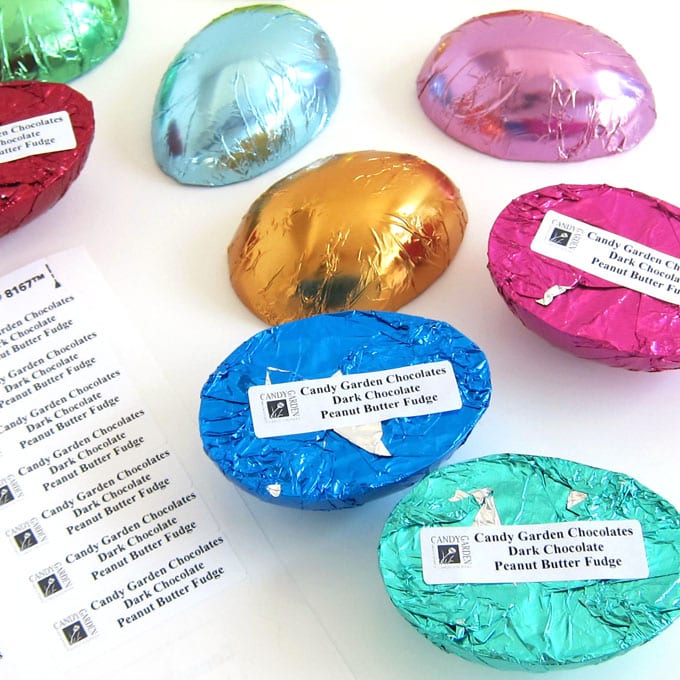
Wrap in foil and add labels.
- Buy 6-inch square candy foil wrappers and cut them as needed to wrap your eggs. I cut mine down to about a 5-inch square.
- Unfortunately, the foils only come in 6-inch, 4-inch, and smaller pieces. The 4-inch squares are not large enough to cover the eggs I make using a polycarbonate egg mold (with 10 egg cavities).
If you wrap your chocolate bark eggs in a variety of colored foil and you make more than one flavor chocolate egg, I suggest you print out labels to affix to the underside of each egg so you can tell them apart.
- I use return address labels.
- Go to the Avery website and use their templates to easily add your flavor names to each label.
- Print them out then stick them to the bottoms of the eggs.
If you don't want to print out labels, you can wrap each flavor of chocolate egg in a different color foil, then print out a color chart with matching egg flavor listed.

The chocolate eggs look so pretty wrapped in foil and snuggled in an Easter basket.
Printable Recipe
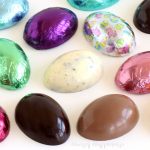
Make solid chocolate Easter eggs or chocolate bark eggs filled with cookies, nuts, toffee bits, cereal, and more.
Course: Dessert
Cuisine: American
Keyword: chocolate, chocolate bark, chocolate Easter eggs, chocolate eggs, Easter recipe
Servings: 10
Calories: 202 kcal
Solid Chocolate 3-D Easter Eggs
- 26 ounces milk, dark, or white chocolate (melted and tempered pure chocolate or melted compound chocolate)
Chocolate Bark Eggs (halves)
- 12 ounces milk, dark, or white chocolate (melted and tempered pure chocolate or melted compound chocolate)
- 1/3-1/2 cup toffee bits, broken cookies, pretzel pieces, cereal, etc.
Solid Chocolate 3-D Easter Eggs
-
Fill the egg-shaped cavities in a candy mold with melted and tempered pure chocolate or melted compound chocolate (candy melts, almond bark, melting wafers, etc.)
-
Tap the mold on the counter a few times to allow any air bubbles to come to the surface and pop.
-
Chill in the refrigerator for about 30 minutes until hardened if using pure chocolate or in the freezer for about 15 minutes if using compound chocolate.
-
Remove and unmold the chocolate eggs.
-
Let the chocolate egg halves come to room temperature for about 30 minutes before attaching them to the other half.
-
Fill one egg-shaped cavity with chocolate, tap to remove air bubbles, then set a solid chocolate egg half over the opening, pressing down to seal the two halves together.
-
Repeat, creating a tray filled with solid 3-D chocolate eggs.
-
Chill until hardened.
-
Pop the solid chocolate eggs out of the mold.
Chocolate Bark Eggs
-
Stir together your mixins and chocolate.
-
Spoon it into the egg mold.
-
Chill until hardened.
-
Unmold.
-
Let come to room temperature before wrapping in foil candy wrappers or cellophane bags.
- Store solid chocolate Easter eggs at room temperature for up to 6 months.
- Store chocolate bark Easter eggs at room temperature for up to 2 months.
- The calories are listed for a solid half-egg. A 3-D chocolate egg has 404 calories.
- You can attach two chocolate bark egg halves together using the technique to make the solid 3-D eggs.
More chocolate Easter recipe ideas…
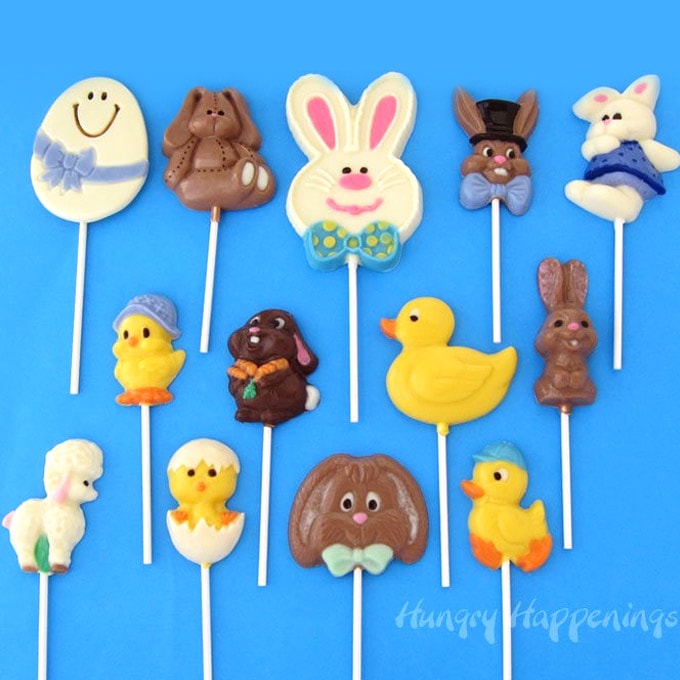
Handmade Easter Candy
Learn how to melt candy melts using an electric skillet so you can keep them warm all day long while you are painting cute Easter bunnies, chicks, ducks, and lambs.

Bunny Butt Pretzels
These chocolate pretzels couldn't look cuter! They are so fun to make for Easter.

Fudge-filled White Chocolate Hatching Chicks
These hatching chick chocolates are cute and delicious!
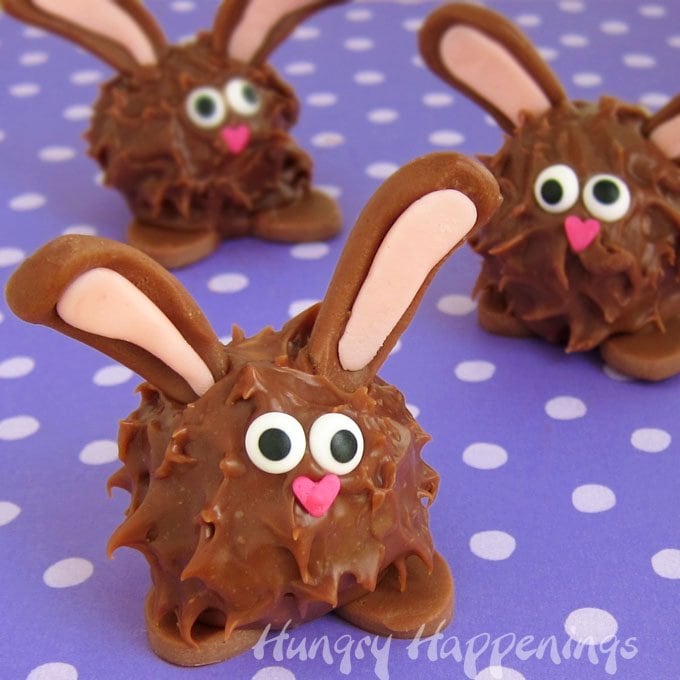
Peanut Butter Fudge Bunnies
Each of these cute chocolate Easter bunnies is filled with creamy peanut butter fudge and is covered in chocolate ganache.

Chocolate dipped swirled marshmallow Easter eggs.
Learn how to swirl milk and dark chocolate together to create beautiful marshmallow eggs.

Did you make this recipe or do you have a question? Let me know by leaving a comment and rating the recipe below. If you love the recipe, please give it a 5-star rating.

I love making fun food for parties and special occasions and sharing my creative ideas with you.
If you make this recipe and share it online be sure to link back to this post and use #hungryhappenings.
Thanks and have a sweet day! –
Beth
How To Make Solid Chocolate Eggs
Source: https://hungryhappenings.com/chocolate-eggs/
Posted by: brustbronds.blogspot.com

0 Response to "How To Make Solid Chocolate Eggs"
Post a Comment